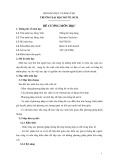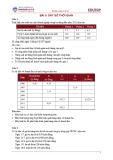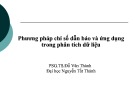Chapter 9
Hypothesis Testing
McGrawHill/Irwin
Copyright © 2014 by The McGrawHill Companies, Inc. All rights reserved.
Hypothesis Testing
9.1 Null and Alternative Hypotheses and
Errors in Testing
9.2 z Tests about a Population Mean
σ Known
9.3 t Tests about a Population Mean
σ Unknown
9.4 z Tests about a Population Proportion 9.5 Type II Error Probabilities and Sample
Size Determination (Optional)
92
LO9-1: Specify appropriate null and alternative hypotheses.
9.1 Null and Alternative Hypotheses and Errors in Hypothesis Testing Null hypothesis, H0, is a statement of the basic
convincing sample evidence that it is false Alternative hypothesis, Ha, is an alternative accepted only if there is convincing sample evidence it is true
proposition being tested ◦Represents the status quo and is not rejected unless there is
μ0 vs. Ha: μ > μ0
OneSided, “Greater Than” H0: μ (cid:0) OneSided, “Less Than” H0 : μ (cid:0) TwoSided, “Not Equal” H0 : μ = μ0 vs. Ha : μ (cid:0) where μ0 is a given constant value (with the appropriate units) that is a comparative value
93
μ0 vs. Ha : μ < μ0 μ0
LO9-1
Types of Decisions
As a result of testing H0 vs. Ha, will decide either of the following decisions for the null hypothesis H0: ◦Do not reject H0 or reject H0
To “test” H0 vs. Ha, use the “test statistic”
0
0 n
x
z measures the distance between μ0 and on the
sampling distribution of the sample mean
If the population is normal or n is large*, the test
statistic z follows a normal distribution
94
(cid:0) (cid:0) (cid:0) (cid:0) x x (cid:0) (cid:0) z (cid:0) (cid:0)
LO9-2: Describe Type I and Type II errors and their probabilities.
Error Probabilities
Type I Error: Rejecting H0 when it is true is the probability of making a Type I error
is the probability of not making a Type I
Type II Error: Failing to reject H0 when it is
◦(cid:0) ◦1 – (cid:0) error
false ◦β is the probability of making a Type II error ◦1 – β is the probability of not making a Type II
95
Table 9.1
error
LO9-2
Typical Values
Usually set (cid:0)
to a low value ◦So there is a small chance of rejecting a true H0
Typically, (cid:0)
= 0.05
(cid:0)
= 0.01 requires very strong evidence to reject H0 and β
Tradeoff between (cid:0)
◦Strong evidence is required to reject H0 ◦Usually choose α between 0.01 and 0.05
And the higher (cid:0)
, the lower β
96
◦For fixed sample size, the lower (cid:0) , the higher β
LO9-3: Use critical values and p-values to perform a z test about a population mean when σ is known.
9.2 z Tests about a Population Mean: σ
Known
Test hypotheses about a population mean
using the normal distribution
Called z tests Require that the true value of the population
standard deviation σ is known ◦In most realworld situations, σ is not known But often is estimated from s of a single sample When σ is unknown, test hypotheses about a
population mean using the t distribution
97
◦Here, assume that we know σ
LO9-3
Steps in Testing a “Greater Than” Alternative 1. State the null and alternative hypotheses 2. Specify the significance level α 3. Select the test statistic 4. Determine the critical value rule for deciding
5. Collect the sample data and calculate the value of
whether or not to reject H0
6. Decide whether to reject H0 by using the test
7.
the test statistic
98
statistic and the rejection rule Interpret the statistical results in managerial terms and assess their practical importance
LO9-4: Use critical values and p-values to perform a t test about a population mean when σ is unknown.
9.3 t Tests about a Population Mean: σ Unknown
Assume the population being sampled is
normally distributed
The population standard deviation σ is
unknown, as is the usual situation ◦If the population standard deviation σ is
Under these two conditions, have to use the t
unknown, then it will have to estimated from a sample standard deviations
distribution to test hypotheses
99
LO9-5: Use critical values and p-values to perform a large sample z test about a population proportion.
9.4 z Tests about a Population Proportion
Alternative
pvalue
Reject H0 if:
z > z(cid:0)
Ha: ρ > ρ0
Area under t distribution to right of z
z < –z(cid:0)
Ha: ρ < ρ0
Area under t distribution to left of –z
|z| > z (cid:0)
Ha: ρ (cid:0)
ρ0
/2 *
Twice area under t distribution to right of |z|
pˆ
p
(cid:0)
Where the test statistics is
z
(cid:0)
p
0 p
0
0
1(cid:0) n
* either z > zα/2 or z < –zα/2
910
(cid:0) (cid:0)
LO9-6: Calculate Type II error probabilities and the power of a test, and determine sample size (Optional).
9.5 Type II Error Probabilities and Sample Size Determination (Optional) Want the probability β of not rejecting a false null
1 β is called the power of the test Assume that the sampled population is normally
hypothesis ◦Want the probability β of committing a Type II error
Test…
◦H0: µ = µ0 vs ◦Ha: µ < µ0 or Ha: µ > µ0 or Ha: µ ≠ µ0
Want to make the probability of a Type I error equal
distributed, or that a large sample is taken
911
to α and randomly select a sample of size n
LO9-6
Calculating β Continued
The probability β of a Type II error
corresponding to the alternative value µa for µ is equal to the area under the standard normal curve to the left of
a
0
(cid:0) (cid:0) (cid:0)
(cid:0) *z
Here z* equals zα if the alternative hypothesis
(cid:0) n
is onesided (µ < µ0 or µ > µ0)
Also z* ≠ zα/2 if the alternative hypothesis is
twosided (µ ≠ µ0)
912


























